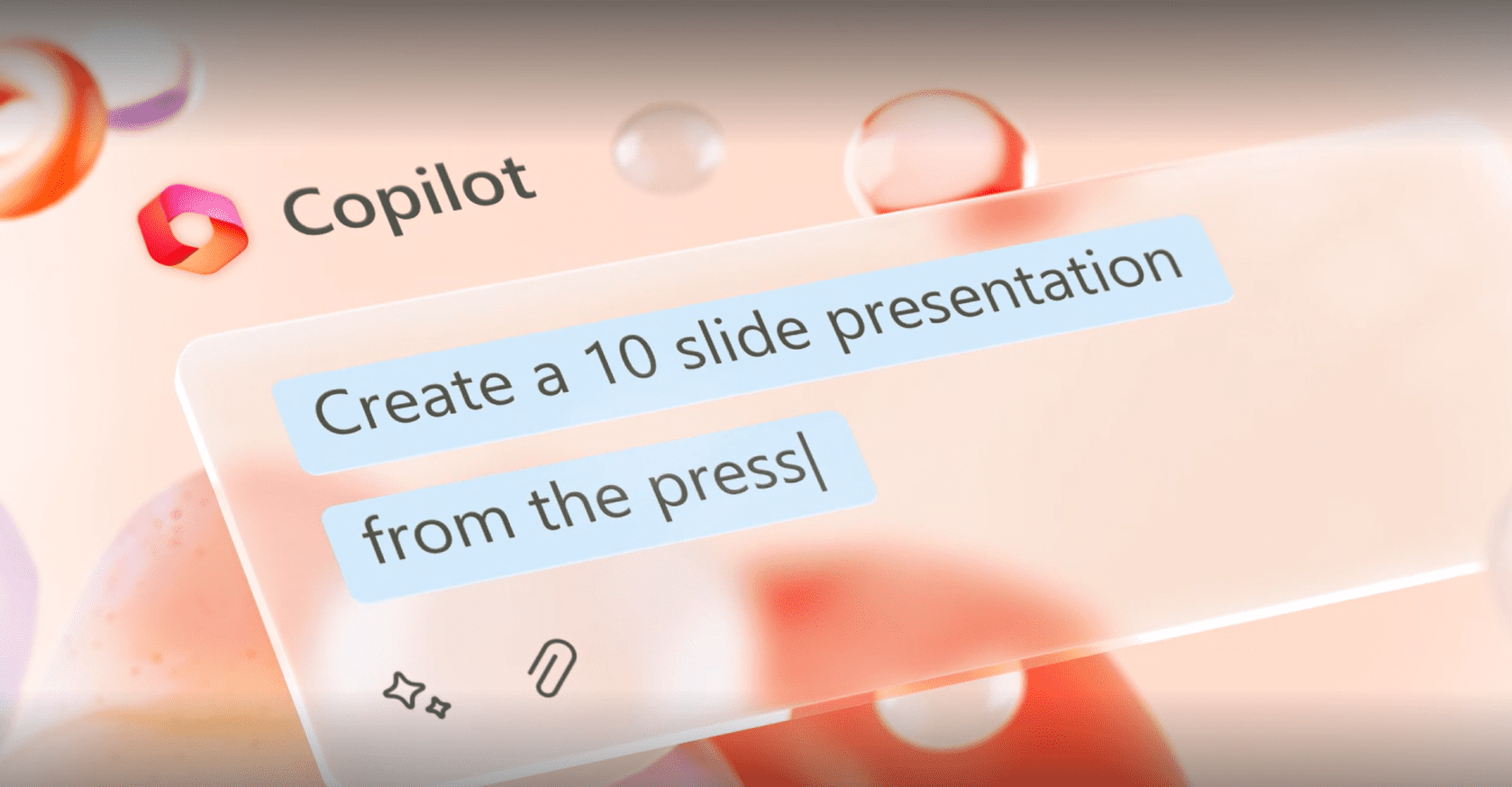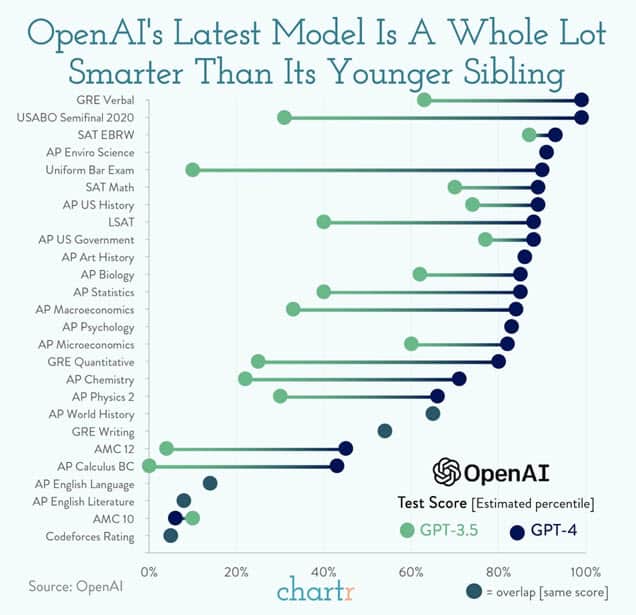Microsoft’s Massive Upgrade: OpenAI CoPilot For Entire MS 365 Suite.
Microsoft is betting the farm on OpenAI and ChatGPT with the biggest upgrade to Microsoft 365 in decades. The new release, entitled Microsoft 365 Copilot, delivers Generative AI tools and chat embedded in every module in the suite: Word, Excel, PowerPoint, Outlook, Teams and Viva. They call it “Your Copilot for Work.”
And there’s more: not only does Copilot help you write, summarize, analyze, and search for information, a module called Business Chat works across the entire Microsoft Graph (the data set of all your Microsoft documents, emails, schedules, and information) to help you find materials, summarize them, and index them for business applications.
What it does is pretty amazing, and I’m sure this is just the beginning. Using the GPT-4 Large Language Model (LLM), the CoPilot can draft letters or documents, summarize information, create PowerPoint slides, and analyze data from Excel. It’s intelligent enough to outline and summarize meetings, analyze a spreadsheet, and select graphics that fit the text or message of a presentation. And by accessing the calendar and your contacts it can give you a history of work, activities, and projects.
 |
In some sense this is as big as the invention of the spreadsheet itself. Everyone is going to have to learn to use this tool, because ignoring it will put you behind.
The word Copilot is significant: you are flying the plane, and he (or she) is there to help you. You can easily modify or iterate its creations, so it’s your “trusty assistant” ready to help but also ready to stay out of the way.
Under the covers the Copilot is learning about your documents, schedule, and communications, so it gets smarter as you use it. The LLM does not share your local data, but you can “ground it” in your local information, so it develops “skills” (an AI term for learning) based on your information. Imagine you analyze a spreadsheet and figured out an analysis of sales by product. The Copilot would remember that work and you could make it available to others.
The use-cases are overwhelming. If you miss a meeting you can ask the Copilot what was discussed and whether Susan, for example, discussed the big project you’re working on. You can rewrite text and tell the Copilot what “tone to use.” You can ask the Copilot to find emails about a topic and summarize what was agreed. And the Business Chat can summarize across everything, answering questions like “summarize all the communications and information on last night’s outage.”
 |
I’ve been using Bing Chat for several weeks now, and I can attest that GPT-4 works very well. Its language abilities are superb, even though the quality of information on the internet may confuse it. But once it works on your documents, which are validated and edited by you, the tool will be astounding. And just being able to search, find, and summarize things makes you realize that search, alone, is not enough. (Yes Google will be threatened by this technology.)
This week OpenAi released GPT4, which is the engine behind Bing Chat. It is significantly faster and smarter than it’s younger sibling, demonstrating how fast these neural networks are evolving.
 |
One of the vendors I trust told me last week that GPT-4 is the first AI model that actually learns faster than humans. He believes that this neural network is able to learn for itself, enabling the system to continuously improve its results. (Read the GPT4 research paper here.)
And Google, not to be left behind, introduced its own Generative AI for Google Workspace. I sense the Google folks are trying to keep up with Microsoft, so their introduction felt incomplete. They are clearly sitting on a massive announcement of their own, but the Microsoft – OpenAI momentum is massive. And to double down on the effort, LinkedIn announced a series of AI enhancements built on OpenAI too.
The Many Implications Of This Announcement
Microsoft Has Been Trying To Improve Productivity For 40 Years
 Let me start at the beginning: Microsoft’s focus on business productivity is relentless, so they understand how we use our computers. While some releases have been amazing (the ribbon, for example), many turned into duds. (Remember Clippy? Or Microsoft Bob?) Microsoft learned that “making systems easy” is hard. The simplistic tools get in the way: we need a tool that learns as we progress.
Let me start at the beginning: Microsoft’s focus on business productivity is relentless, so they understand how we use our computers. While some releases have been amazing (the ribbon, for example), many turned into duds. (Remember Clippy? Or Microsoft Bob?) Microsoft learned that “making systems easy” is hard. The simplistic tools get in the way: we need a tool that learns as we progress.
That’s why Microsoft may have nailed it this time. The Copilot is good for starting something from scratch and also for fine-tuning your masterpiece. It’s only an aid so you can ignore it or turn it off at any time. And the idea of a Copilot sense: Microsoft’s GitHub Copilot for software engineers is huge. The GitHub Copilot shows programmers how to improve their code while they type, revolutionizing the idea of “pair programming.” And since the LLM is essentially a “learning machine,” your Copilot will get better over time.
 |
And let me assure you that these tools really work.
I recently cited a study by MIT which showed a 39% improvement in productivity from ChatGPT alone. The Copilot, which is precisely designed for you, will increase this number in short time. Imagine the time savings in writing a memo, letter, or report when the Copilot can give you an outline or summary to start. Lawyers, writers, marketers, and sales people will save hours out of the box.
Partners and IT: Lots Of Add-Ons To Build
Since the Copilot is built on the Azure OpenAI Services, we can expect a new industry of add-ons to appear. Hundreds of IT departments and Microsoft integrators will learn how to tune this system, build “skills” (models), and develop industry use-cases for our benefit. Imagine how much work it would save lawyers, for example, when they try to craft arguments for long-running cases. We should start to see Copilot “skills” for legal, marketing, sales, and hundreds of applications.
IT departments will do the same. Since the system is based on the security used by Microsoft Graph (ie. your company directory), IT teams can also build skills to help various user groups do things faster (or more accurately). I remember the labyrinth of rules we had at Deloitte to ensure global compliance. These could be built into the Deloitte Copilot (as an example) and every consultant would get help.
Note that Microsoft also introduced Copilot for Power Platform, making it easier to build apps that leverage this toolset.
Competition: Google And Others Respond
While Google seems behind in this race, I don’t expect them to stay quiet. More than 2 billion people use the free versions of Gmail around the world, so the use of Generative AI will go mainstream. I also think we’ll see many other LLMs enter the market, with specialized uses in different domains. (We are excitedly working on an LLM for our research and training.)
Is This Risky?
And then there’s the topic of risk. The OpenAI research paper describes risks as “… risks we foresee around bias, disinformation, over-reliance, privacy, cybersecurity, proliferation, and more,” referring to the potential for the system to make errors, amplify mistakes, and mislead people.
Despite the New York Times’ discussions about how “scary” this is, I have to guess the first spreadsheet was frightening too. I was working at IBM in 1981 when Lotus 1-2-3 and other tools emerged and many people thought “this is the end of the accounting profession.”
I would remind you that Generative AI is not the discovery of a new form of life. These are statistical reasoning tools that we can use for our benefit. As with every technology, some people will use them for bad behavior. Have you noticed how much spam and clickbait we get in email? I don’t think we’re throwing that away any time soon.
A Massive Investment (And Bet) For Microsoft
I have to give Satya Nadella a lot of credit for this work: it sometimes seems like everyone at Microsoft is suddenly working with OpenAI. Not only is Microsoft “betting the company” on Generative AI tools, they’re building the infrastructure to support it. One reporter found out that Microsoft is buying up all the AI chips, building capacity for the Copilots.
This just means Microsoft is moving down the learning curve at light speed. Other software vendors are scrambling to catch up.
Will This Bring The Long-Awaited Productivity Bonanza We Seek?
Finally, let’s discuss productivity. Will these tools make work so easy the 4-day workweek goes mainstream? Will jobs like “copywriter” become obsolete?
Well in my 45 years in business, I’ve noticed that every major productivity tool “improves work” for people. When voicemail and email appeared we wondered if secretaries would go away (they did). When Zoom and Teams emerged we redesigned our offices.
In this case I doubt we’ll run out of things to do but we can do things faster and better than before. So if you ignore this trend and choose not to learn these tools, you’re simply going to fall behind.
I applaud Microsoft for this massive investment. While we’re still in early days, I am rooting for success. Productivity, here we come.
Additional Information
The Role Of Generative AI And Large Language Models in HR
New MIT Research Shows Spectacular Increase In White Collar Productivity From ChatGPT
LinkedIn Announces Generative AI Features For Career, Hiring, and Learning
Microsoft Launches OpenAI CoPilots For Dynamics Apps And The Enterprise.
Understanding Chat-GPT, And Why It’s Even Bigger Than You Think (*updated)


